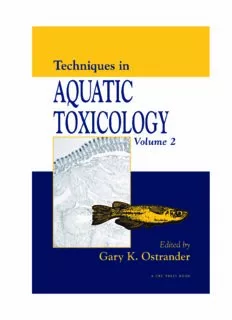Table Of ContentOstrander/TechniquesinAquaticToxicology L1664_prelims FinalProof page 1 21.12.2004 10:06am
Techniques in Aquatic Toxicology
Volume II
Ostrander/TechniquesinAquaticToxicology L1664_prelims FinalProof page 2 21.12.2004 10:06am
Ostrander/TechniquesinAquaticToxicology L1664_prelims FinalProof page 3 21.12.2004 10:06am
Techniques in Aquatic Toxicology
Volume II
Edited by Gary K. Ostrander
Ostrander/TechniquesinAquaticToxicology L1664_prelims FinalProof page 4 21.12.2004 10:06am
LibraryofCongressCataloging-in-PublicationData
CatalogrecordisavailablefromtheLibraryofCongress
This book contains information obtained from authentic and highly regarded sources. Reprinted material is
quotedwithpermission,andsourcesareindicated.Awidevarietyofreferencesarelisted.Reasonableefforts
have been made to publish reliable data and information, but the author and the publisher cannot assume
responsibilityforthevalidityofallmaterialsorfortheconsequencesoftheiruse.
Neitherthisbooknoranypartmaybereproducedortransmittedinanyformorbyanymeans,electronicor
mechanical,includingphotocopying, microfilming, andrecording,or byany informationstorageor retrieval
system,withoutpriorpermissioninwritingfromthepublisher.
Allrightsreserved.Authorizationtophotocopyitemsforinternalorpersonaluse,orthepersonalorinternaluse
ofspecificclients,maybegrantedbyCRCPress,providedthat$1.50perpagephotocopiedispaiddirectlyto
Copyright Clearance Center, 222 Rosewood Drive, Danvers, MA 01923 USA. The fee code for users of the
Transactional Reporting Service is ISBN 1-56670-664-5/05/$0.00þ$1.50. The fee is subject to change without
notice.FororganizationsthathavebeengrantedaphotocopylicensebytheCCC,aseparatesystemofpayment
hasbeenarranged.
TheconsentofCRCPressdoesnotextendtocopyingforgeneraldistribution,forpromotion,forcreatingnew
works,orforresale.SpecificpermissionmustbeobtainedinwritingfromCRCPressforsuchcopying.
DirectallinquiriestoCRCPress,2000N.W.CorporateBlvd.,BocaRaton,Florida33431.
TrademarkNotice:Productorcorporatenamesmaybetrademarksorregisteredtrademarks,andareusedonly
foridentificationandexplanation,withoutintenttoinfringe.
VisittheCRCPressWebsiteatwww.crcpress.com
(cid:1)2005byCRCPress
NoclaimtooriginalU.S.Governmentworks
InternationalStandardBookNumber1-56670-664-5
LibraryofCongressCardNumber
PrintedintheUnitedStatesofAmerica1234567890
Printedonacid-freepaper
Ostrander/TechniquesinAquaticToxicology L1664_prelims FinalProof page 5 21.12.2004 10:06am
Dedication
Bookssuchasthisareusuallydedicatedtofamilymembers,colleagues,collaborators,or
mentors who have played a meaningful role in the author’s life and career. Sometimes,
however, some of the most significant people in our lives are outside the circle of our
family or our discipline.
IdedicatethisvolumetothefolksatJohnsonOrchardsinYakima,Washington,andin
particular to Roy Johnson, Jr. (‘‘Mister Johnson’’), Donna Johnson, and Eric Johnson.
I gratefully acknowledge that for many years I always had employment, whether it be
for a summer or for a few hours over a weekend home from college. More importantly,
I am most appreciative for their always believing in me and supporting me, no matter
what objective I was pursuing. This hasbeen true for nearly 30 years.
Ostrander/TechniquesinAquaticToxicology L1664_prelims FinalProof page 6 21.12.2004 10:06am
Ostrander/TechniquesinAquaticToxicology L1664_prelims FinalProof page 7 21.12.2004 10:06am
Preface
The initial volume in this series was published in 1996 and was well received by the
scientificcommunity.Infact,ithasbeenmostgratifyingtoobservethevolumeenteringa
second printing and the positive feedback I continue to receive from colleagues around
the world. While the original intent was to follow with additional volumes every 2 to 3
years (wishful thinking!), other commitments have dictated a more modest approach.
Nonetheless, herein Iam pleasedto present 39additional techniqueschapters.
AswithVolume1,thisvolumecontainsablendofestablishedandrecentlydeveloped
techniques that have the potential to significantly impact the expansive field of aquatic
toxicology.Ihavedividedthechaptersintofourbroadsectionstoincludetechniquesfor
assessmentoftoxicityinwholeorganisms,cellularandsubcellulartoxicity,identification
and assessment of contaminants in aquatic ecosystems, and I conclude with a general
techniques section, techniques for aquatic toxicologists, which contains chapters that
could beof value for anyoneworkingin this field.
Each of the individual chapters covers a specific procedure in detail. A brief
Introduction serves to highlight the technique and the Materials section provides a very
detailed list of what is needed to conduct the procedure(s). The Procedures sections are
written so that the procedure can be easily followed and reproduced by a technician,
graduate student, or someone with a basic knowledge of the field. In the Results and
Discussionsection,Ihaveaskedthecontributorstoprovideanddescribetypicalresults,as
wellasanomalousresults,falsepositives,artifacts,etc.Insomeinstances,thecontributors
haveprovideddatafromtheirrecentlypublishedwork.Alternatively,somecontributors
have provided the data and discussed the previously unpublished experiments. Each
chapterconcludeswithalistofpertinentReferencesandafewalsoincludeappendicesas
necessary.
In addition to my review, all the chapters in this volume were reviewed by at least
one individual with appropriate subject matter expertise. I am most grateful to the
following scientists for providing thoughtful commentaries on one or more (usually
more!) of the manuscripts contained herein: Gary Atchison, Keith Cheng, Dominic M.
Di Toro, Craig Downs, Damjana Drobne, HowardFairbrother, Jeffrey P. Fisher, Douglas
J.Fort,MarcM.Greenberg,MaryHaasch,WilliamE.Hawkins,JamesP.Hickey,JamesN.
Huckins,DavidJanz,J.McHughLaw,LawrenceLeBlanc,PaulMcCauley,MarkS.Myers,
DanaPeterson,TaylorReynolds,ColleenS.Sinclair,TerryW.Snell,LarryG.Talent,and
Rebecca Van Beneden.
Finally, I express my sincere appreciation to the contributors for taking the time to
distill their techniques into a consistent, easily accessible format. I believe that this
consistency, more than anything else, has contributed to the success and the utility of
this series.
Ostrander/TechniquesinAquaticToxicology L1664_prelims FinalProof page 8 21.12.2004 10:06am
Ostrander/TechniquesinAquaticToxicology L1664_prelims FinalProof page 9 21.12.2004 10:06am
About the Editor
Gary K. Ostrander received a B.S. degree in biology from Seattle University in 1980, an
M.S.degreeinbiologyfromIllinoisStateUniversityin1982,andhisPh.D.degreein1986
fromtheCollegeofOceanandFisheriesSciencesattheUniversityofWashington,where
he specialized in aquatic toxicology. He was an NIH postdoctoral fellow in the Depart-
mentofPathology,SchoolofMedicine,attheUniversityofWashingtonfrom1986to1989
and also served as a staff scientist at the Pacific Northwest Research Foundation from
1986 to 1990.
In 1990, he joined the Department of Zoology at Oklahoma State University as an
assistant professor and was tenured and promoted to the rank of associate professor in
1993. He assumed a dual role as director of the Environmental Institute and associate
dean of theGraduate College in 1995.
Dr.OstranderjoinedthefacultyatJohnsHopkinsUniversityin1996andiscurrently
the associate provost for research and chair of the Graduate Board at Johns Hopkins
University. He holds his academic appointments in the Department of Biology in the
SchoolofArtsandSciencesandintheDepartmentofComparativeMedicineintheSchool
of Medicine.
Dr. Ostrander has authored over 80 technical papers and book chapters, edited
4books,andhaswrittenafieldguide.Hisprimaryresearchinteresthasbeenelucidating
mechanisms of chemical carcinogenesis for which he employed aquatic, rodent, and
humanmodels.Asecondaspectofhisworkhasbeenlaboratoryandfieldstudiesfocused
on understanding the mechanisms behind the worldwide decline of coral reef ecosys-
tems.
Description:Whether considering toxicant exposure in zebrafish, or the application of cellular diagnostics to marine toxicology, or the ecotoxicology of coral reef ecosystems, or the amount of metalloids in water, this reference offers the protocols for specimen collection that researchers need. Following up on

